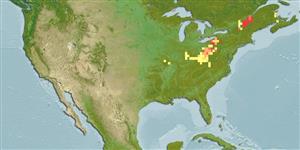Classification / Names
Common names | Synonyms | Catalog of Fishes (gen., sp.) | ITIS | CoL | WoRMS | Cloffa
Actinopterygii (ray-finned fishes) >
Cypriniformes (Carps) >
Cyprinidae (Minnows or carps) > Leuciscinae
Etymology: Exoglossum: Greek, exos = outside + Greek, glossa = tongue (Ref. 45335).
Environment / Climate / Range
Ecology
Freshwater; demersal. Temperate, preferred ?; 47°N - 37°N
North America: Atlantic Slope from St. Lawrence River drainage in Quebec, Canada to upper Roanoke River in North Carolina, USA (absent in most of New England; present in Connecticut River, Vermont based on single record); Lake Ontario drainage in Ontario, Canada and New York, USA. Also present in upper New River drainage in West Virginia and Virginia, USA where may be based on introduction.
Size / Weight / Age
Maturity: Lm ? range ? - ? cm
Max length : 16.0 cm TL male/unsexed; (Ref. 86798); common length : 10.8 cm TL male/unsexed; (Ref. 12193); max. reported age: 2 years (Ref. 12193)
Exoglossum maxillingua resembles tonguetied minnow, E. laurae, but can be distinguished by the presence of much larger fleshy lobe on each side of lower jaw, well separated from central bony plate and followed by another fleshy lobe on underside of head, and by absence of barbel near corner of mouth (Ref. 86798).
Inhabits rocky pools and runs of creeks and small to medium rivers. Usually found in quiet water near boulders. Males construct large circular or rectangular nests by piling pebbles carried in the mouth (Ref. 5723, 86798). Feeds on insects and mollusks (Ref. 54729).
Life cycle and mating behavior
Maturity | Reproduction | Spawning | Eggs | Fecundity | Larvae
Page, L.M. and B.M. Burr, 2011. A field guide to freshwater fishes of North America north of Mexico. Boston : Houghton Mifflin Harcourt, 663p. (Ref. 86798)
IUCN Red List Status (Ref. 115185)
CITES (Ref. 94142)
Not Evaluated
Threat to humans
Harmless
Human uses
More information
Common namesSynonymsMetabolismPredatorsEcotoxicologyReproductionMaturitySpawningFecundityEggsEgg development
ReferencesAquacultureAquaculture profileStrainsGeneticsAllele frequenciesHeritabilityDiseasesProcessingMass conversion
Tools
Special reports
Download XML
Internet sources
